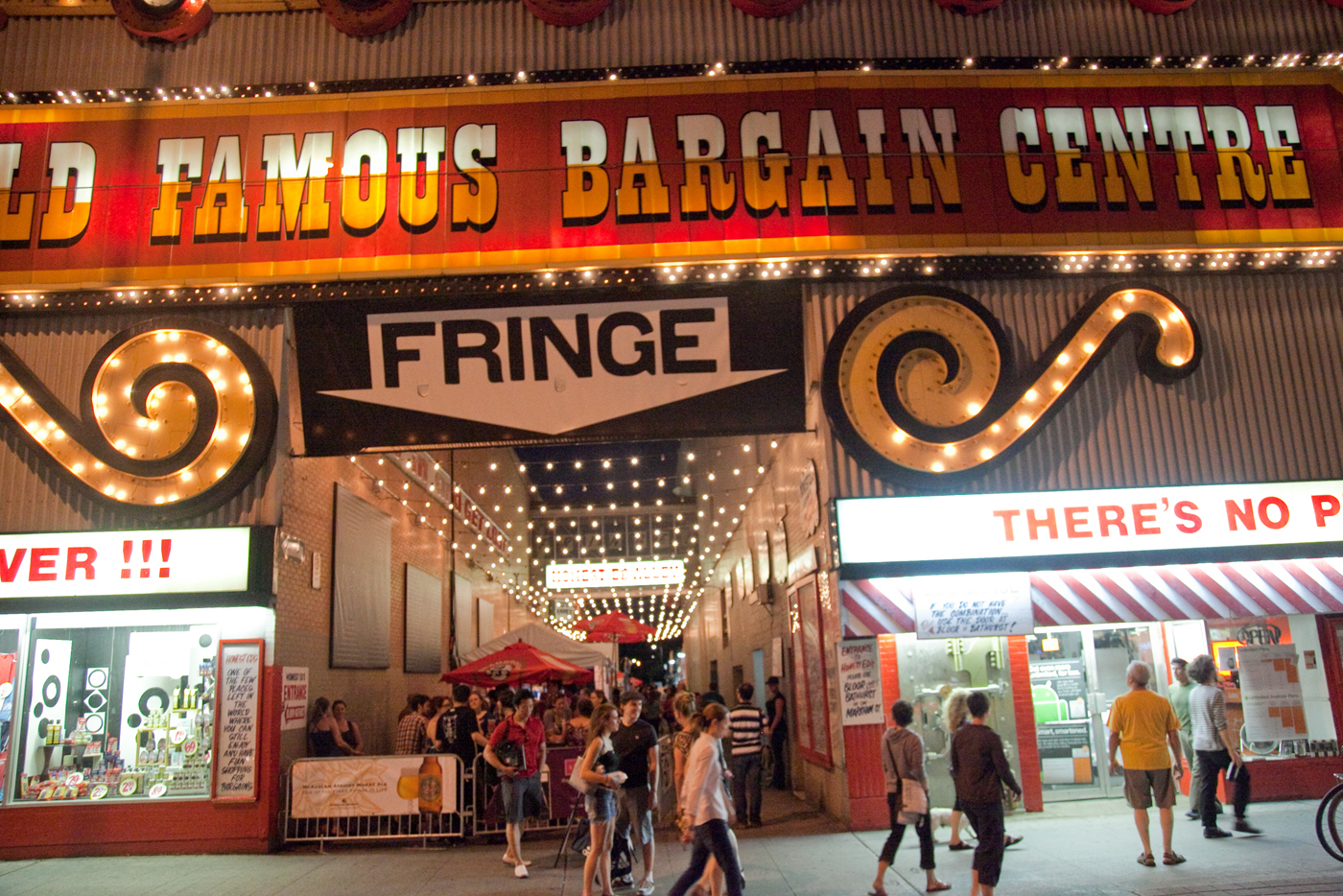The End of Honest Ed’s
One evening several years ago, former Fringe Festival executive director Gideon Arthurs strolled down Bloor Street and noticed the string of lights illuminating the alleyway between the halves of Honest Ed’s. The festival was looking for a new site for its hub, having outgrown the Tranzac Club. While that venue had long served the festival well, it only held two hundred people and, to placate neighbours, had to move everyone inside from the beer tent at 11 p.m. sharp.
Having studied potential sites among local parks, schools, and concrete lots, inspiration struck Arthurs as he looked down the laneway. It was, he recalls, “an awesome corner of untapped urban potential.” It helped that the festival had good relations with the Mirvish organization, which had remounted Fringe hits like Da Kink in My Hair and The Drowsy Chaperone.
Since 2010, that alley, and its adjacent parking lot, has served as the festival’s hub, the Fringe Club. With the closing of Honest Ed’s later this year to make way for the Mirvish Village redevelopment, many visitors to this year’s Club will reflect on the past six years as it says goodbye to the site.
When designing the new hub, Arthurs was inspired by principles of the fringe movement: openness, accessibility, and especially inclusion. “What I wanted more than anything else was as many people as possible to feel like the Fringe Festival was theirs.” Breaking away from the evening talk-show format for previewing productions that he inherited, Arthurs desired a space where performers the public could mingle in a relaxed setting. Touring the site for the first time, festival staff thought, “Great, this is a parking lot,” laughs current executive director Kelly Straughan, then the volunteer coordinator.
The first year’s learning curve included hiccups such as a late-night cabaret whose noise annoyed neighbours. But the lines of communication with the Palmerston Area Residents’ Association stayed open. When a truck with a large sound-dampening wall was utilized early on, the neighbours took it as a sign of good faith of the festival’s intentions to work with them, and it was soon discarded. The festival later patrolled the neighbourhood to prevent rowdiness after the Fringe Club let out.
Other early onsite entertainment experiments included an “art wank” stage, which offered open half-hour performance slots. According to Straughan, festival performers preferred socializing in the tent than adding more stage time to their day. Live music didn’t work either. Finally, buskers were brought in, whose acoustic, non-intrusive presence was a perfect match. A non-curated visual fringe component of fine arts gave way to a curated show of handcrafted items from local artists for sale run by Arts Market.

Dance parties, usually held in the underground parking lot, livened up the hub’s early years. One that was held on the final night of the 2011 Fringe created one of Arthurs’ strongest theatrical experiences. It began with the final minutes of a fifty-two-hour marathon of Waiting for Godot down below, which drew around three hundred spectators. “People in the audience were crying and cheering,” Arthurs recalls. “It was very moving. We all walked up the ramp into the parking lot of Honest Ed’s, where there was a huge party happening. People started dancing, and by the end of the night, people counted down until last call as if it were New Year’s. There was a huge cheer and I thought, ‘This is what the future of theatre should be. This joy, and fun, and communion over making art of all kinds.’ I was inspired to recreate that moment many, many times.”
For several years, the hub launched the festival with a “poster sprint.” Fringe artists waited for dignitaries like David Mirvish and Olivia Chow to give the signal to run down the alley to claim prime real estate for their posters. Boards were plastered in under a minute. Large crowds watched the spectacle, which sometimes resembled a costumed version of the running of the bulls.
The Fringe After Dark program was launched in 2013 to create a more inclusive, participatory atmosphere that didn’t make the hub seem like it was a party just for the indie arts sector. Icebreaking activities included board games, button-making, telling ghost stories, and mixing yoga with beer. “People want to stay and participate,” Straughan says, “and sometimes just need an excuse to talk with someone, or engage in an activity.” She particularly enjoyed the table-flipping station set up one year. “People really got involved,” she recalls. “They would do scenes leading up to it, they would set up their characters. How often do you get to just smash stuff?”
Maintaining a good relationship with Honest Ed’s management means Fringe participants have free reign to come up with ideas like a table-flipping station. One year, there was even a nude dancing tent, though few onlookers did more than strip off their shirts. “It has been one of the easiest partnerships,” says Straughan. Store general manager Russell Lazar has been a strong supporter, who “wants to say yes to everything.” When an idea has been too bizarre or impractical, Lazar has been apologetic while explaining why it wouldn’t work.
Before the hub moves on to its next home, a final salute to the site will be held on July 9. That night, echoing one of Honest Ed’s most famous traditions, David Mirvish will be present during the handout of paper turkeys for attendees to write their memories on. As the turkeys are placed on a wall, a last toast will be held at 10 p.m.
“What’s been incredible about the Fringe Club, and I’m sure a lot of artists would say the same thing, is that it becomes the place the indie arts community meets up for twelve days,” says Straughan. “It’s special to walk through the club and go, ‘Wow, look at all these people hanging out.’ Even some artistic directors come out, people you wouldn’t expect, because it’s a chance for them to see their friends and be in the club. What other equivalent do we have where we know that everyone will be there and we can talk about what it’s like to be an artist?”










Very good written article. It will be useful to everyone who employess it, including myself. Keep up the good work – can’r wait to read more posts.